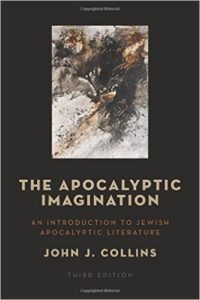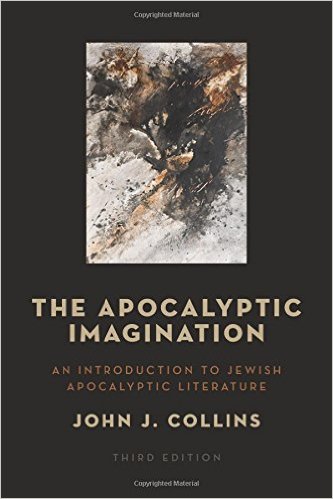 The Apocalyptic Imagination: An Introduction to Jewish Apocalyptic Literature, 3rd ed., by John J. Collins (Eerdmans, 2016), 442 pages.
The Apocalyptic Imagination: An Introduction to Jewish Apocalyptic Literature, 3rd ed., by John J. Collins (Eerdmans, 2016), 442 pages.
The first edition of John Collins’ Apocalyptic Imagination was published more than 30 years ago. The second edition was published seventeen years ago. The third edition updates this time-tested textbook to take account of the last seventeen years of scholarship, which has shown immense interest in apocalyptic literature and its relevance for New Testament interpretation.
The definition of apocalyptic is always contested. Collins follows the SBL Genre Project’s definition, that apocalyptic is “a genre of revelatory literature with a narrative framework, in which a revelation is mediated by an otherworldly being to a human recipient, disclosing a transcendent reality which is both temporal, insofar as it envisages eschatological salvation, and spatial insofar as it involves another, supernatural world” (5). The rest of chapter one surveys for fifty pages what apocalyptic is, including its manifestation in different cultures such as Babylonians, Persians, etc.
The rest of the chapters survey the rest of the Jewish and Christian apocalyptic literature. A useful discussion on historical and literary criticism of the Enoch literature, particularly 1 Enoch, comprises chapter two. Daniel is covered in chapter three. Collins takes the typical position that Daniel was written in the second century BC, which means it falls into the similar historical matrix of the other apocalyptic literature, rather than being an older work that inspired all the rest of the later apocalyptic literature.
Other chapters include those on the Sibylline Oracles, Testaments, literature post-70 AD (4 Ezra, 2 Baruch, Ap. Abraham), diaspora apocalyptic literature, and that of early Christianity, including sections on Paul and more on Revelation.
The fifth chapter is especially well done, covering the Dead Sea Scrolls. Collins wrote an entire book on the subject, Apocalypticism in the Dead Sea Scrolls, much of which he condenses in this chapter. Because of the affinities between Qumran use of the OT and the NT’s use, an understanding of apocalyptic in the Dead Sea Scrolls helps enlighten us further on the same in the New Testament.
This textbook would be especially useful for newer students to biblical studies. Apocalypticism is perhaps one of the more difficult subject to wrap one’s mind around, especially without a comprehensive overview. Diving into 1 Enoch for the first time without proper grounding in apocalyptic can be troubling, and students may not know exactly how relevant such literature is to NT interpretation. But understanding this genre is a vital part of historical interpretation.
Indeed, as Collins notes at the end of the book, “It is perhaps unfortunate that apocalyptic literature is so often invested with theological authority, with an eye to coded message and instructions, rather than being read as an exuberant product of the human imagination. Even more unfortunate is the modern proclivity to reduce the symbolic to propositional truths” (358). These works are difficult for Western minds to read as they were intended to be read. But if we allow ourselves to enter the mindset of early Jews and Christians, we may find ourselves wrapped up in a new way of viewing history and understanding how God is working in it.
I recommend Collins’s textbook highly as an enduring source for proper understanding of apocalyptic literature.
Preview of buy it on Amazon.
Want to learn more about apocalypticism? Check out this intro to apocalypticism, or our annotated bibliography with extensive categorized sources.


